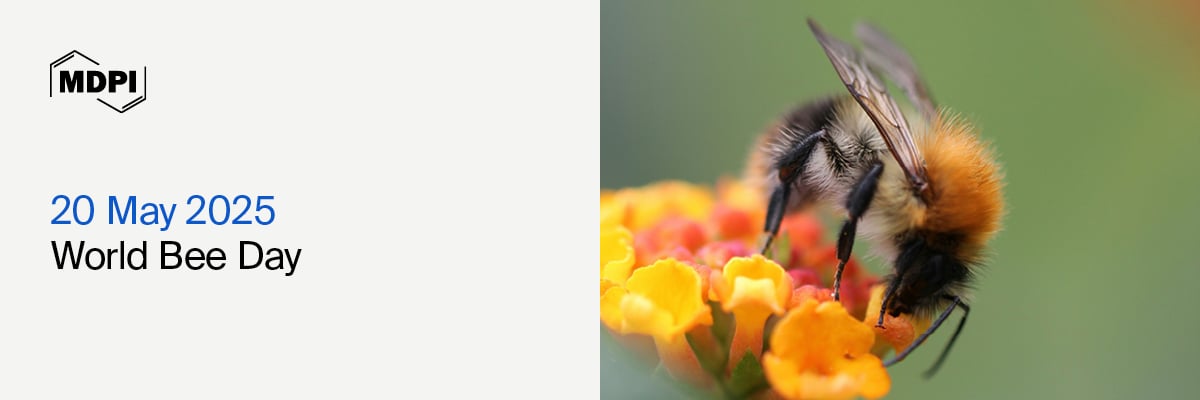
Journal Menu
► ▼ Journal Menu-
- Animals Home
- Aims & Scope
- Editorial Board
- Reviewer Board
- Topical Advisory Panel
- Instructions for Authors
- Special Issues
- Topics
- Sections & Collections
- Article Processing Charge
- Indexing & Archiving
- Editor’s Choice Articles
- Most Cited & Viewed
- Journal Statistics
- Journal History
- Journal Awards
- Society Collaborations
- Conferences
- Editorial Office
Journal Browser
► ▼ Journal BrowserNeed Help?
Announcements
20 May 2025
World Bee Day 2025—“Bee Inspired by Nature to Nourish Us All”, 20 May 2025

World Bee Day, commemorated annually on the 20th of May, was established to raise public awareness of the importance of bees and other pollinators, as well as to promote the coordinated development of sustainable agriculture and ecological protection. This year's theme is “Bee inspired by nature to nourish us all”. As the most critical pollinator in nature, bees directly influence global crop yields and have a profound impact on food security, biodiversity, and economic value chains. The contributions made by bees and other pollinators are closely connected to all of us. However, due to factors such as habitat destruction, the widespread use of pesticides, and climate change, global bee colonies and other pollinators are experiencing a significant decline in population.
MDPI encourages the use of open academic exchange platforms offered by journals from Biology & Life Sciences subject such as Agriculture, Animals, Biology, Conservation, Ecologies, Foods, Insects and Life to promote innovation and practical application in the field of pollinator protection. Research published in these journals is freely accessible to the public. We look forward to leveraging scientific knowledge to help safeguard this fragile link that sustains the Earth's life-support network.

 |
 |
 |
 |
 |
 |
 |
 |

“Climate Change Influences on Central European Insect Fauna over the Last 50 Years: Mediterranean Influx and Non-Native Species”
by Attila Haris, Zsolt Józan, Péter Schmidt, Gábor Glemba, Bogdan Tomozii, György Csóka, Anikó Hirka, Peter Šima and Sándor Tóth
Ecologies 2025, 6(1), 16; https://doi.org/10.3390/ecologies6010016
“Comparative Study of the Effect of Pollen Substitute Diets on Honey Bees during Early Spring”
by Hyunjee Kim, Olga Frunze, Abdulkadir Yusif Maigoro, Myeong-Lyeol Lee, Jeong-Hyeon Lee
and Hyung-Wook Kwon
Insects 2024, 15(2), 101; https://doi.org/10.3390/insects15020101
“Decoding the Behavior of a Queenless Colony Using Sound Signals”
by Dimitrios Kanelis, Vasilios Liolios, Fotini Papadopoulou, Maria-Anna Rodopoulou, Dimitrios Kampelopoulos, Kostas Siozios and Chrysoula Tananaki
Biology 2023, 12(11), 1392; https://doi.org/10.3390/biology12111392
“Conservation of Local Honeybees (Apis mellifera L.) in Southeastern Turkey: A Preliminary Study for Morphological Characterization and Determination of Colony Performance”
by Atilla Oztokmak, Gonca Ozmen Ozbakir and Oznur Çaglar
Animals 2023, 13(13), 2194; https://doi.org/10.3390/ani13132194
“Survey Results of Honey Bee Colony Losses in Winter in China (2009–2021)”
by Jiao Tang, Congcong Ji, Wei Shi, Songkun Su, Yunbo Xue, Jinshan Xu, Xiao Chen, Yazhou Zhao and Chao Chen
Insects 2023, 14(6), 554; https://doi.org/10.3390/insects14060554
“Application of a Quality-Specific Environmental Risk Index for the Location of Hives in Areas with Different Pollution Impacts”
by Daniel Signorelli, Luigi Jacopo D’Auria, Antonio Di Stasio, Alfonso Gallo, Augusto Siciliano, Mauro Esposito, Alessandra De Felice and Giuseppe Rofrano
Agriculture 2023, 13(5), 998; https://doi.org/10.3390/agriculture13050998
“Expression Profile, Regulatory Network, and Putative Role of microRNAs in the Developmental Process of Asian Honey Bee Larval Guts”
by Xiaoxue Fan, Wende Zhang, Sijia Guo, Leran Zhu, Yiqiong Zhang, Haodong Zhao, Xuze Gao, Haibin Jiang, Tianze Zhang, Dafu Chen et al.
Insects 2023, 14(5), 469; https://doi.org/10.3390/insects14050469
“Pollen as Bee Medicine: Is Prevention Better than Cure?”
by Maryse Vanderplanck, Lucie Marin, Denis Michez and Antoine Gekière
Biology 2023, 12(4), 497; https://doi.org/10.3390/biology12040497
Special Issues:
|
“The Impact of Environmental Factors and Pesticides on Bee Behavior” |
“Losses, Health and Wellbeing of Honey Bees Across the World” |
 |

“Pollen Production and Nutrient Composition in Two Northern Highbush Blueberry Cultivars: Implications for Pollinator Nutrition”
by Priyadarshini Chakrabarti, Lauren Baugus, Ethan Eaton, Nathalie A. Steinhauer and Ramesh R. Sagili
Agriculture 2025, 15(5), 461; https://doi.org/10.3390/agriculture15050461
“Further Insights on Honey and Propolis from Gerês (Portugal) and Their Bioactivities: Unraveling the Impact of Beehive Relocation”
by Ana Sofia Freitas, Rui Oliveira, and Cristina Almeida-Aguiar
Life 2024, 14(4), 506; https://doi.org/10.3390/life14040506
“Anti-Herpes Simplex Virus and Anti-Inflammatory Activities of the Melittin Peptides Derived from Apis mellifera and Apis florea Venom”
by Pichet Praphawilai, Thida Kaewkod, Sureeporn Suriyaprom, Aussara Panya, Terd Disayathanoowat and Yingmanee Tragoolpua
Insects 2024, 15(2), 109; https://doi.org/10.3390/insects15020109
“Chemical and Functional Characterization of Propolis Collected from Different Areas of South Italy”
by Aliki Kapazoglou, Maria Gerakari, Efstathia Lazaridi, Konstantina Kleftogianni, Efi Sarri, Eleni Tani and Penelope J. Bebeli
Foods 2023, 12(18), 3481; https://doi.org/10.3390/foods12183481
“Exploring Consumers’ Preferences and Attitudes to Honey: Generation Approach in Slovakia”
by Peter Šedík, Martina Hudecová and Kristína Predanócyová
Foods 2023, 12(10), 1941; https://doi.org/10.3390/foods12101941
“Linking Beekeepers’ and Farmers’ Preferences towards Pollination Services in Greek Kiwi Systems”
by Elie Abou Nader, Georgios Kleftodimos, Leonidas Sotirios Kyrgiakos, Christina Kleisiari, Nicola Gallai, Salem Darwich, Tristan Berchoux, George Vlontzos and Hatem Belhouchette
Animals 2023, 13(5), 806; https://doi.org/10.3390/ani13050806
Special Issues:
|
“Recent Advances and Opportunities of Honey & Bee Products” |
“Application of Machine Learning and Artificial Intelligence in Precision Beekeeping” |







